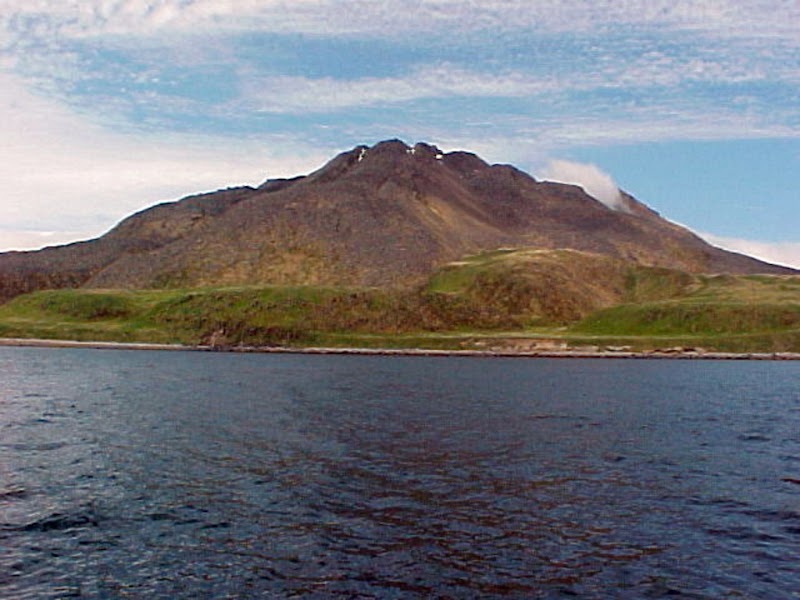
Amak Volcano: Nature's Majesty in Alaska
Amak Volcano: Nature's Majesty in Alaska
Category
Hiking
Typical Duration
2-4 hours
Difficulty
Easy
Photo Gallery

Amak Volcano: Nature's Majesty in Alaska - Amak Volcano
About This Landmark
Volcanic Wonder at Amak Volcano, Alaska
Amak Volcano, located in the remote western Aleutian Islands of Alaska, stands as a striking natural landmark marked by its rugged, volcanic terrain and dramatic views. This dormant stratovolcano rises prominently along the North Pacific edge, offering a bold contrast between aged lava flows and vibrant green tundra that carpets much of the surrounding landscape. Its isolation from the mainland creates a rare opportunity to witness a largely untouched volcanic environment shaped by Alaska’s dynamic geological forces.
The volcano’s surface reveals fascinating features such as hardened lava fields, gentle fumaroles releasing intermittent steam, and mineral-streaked rocks coated by volcanic ash—reminders of Amak’s fiery past. The cool Aleutian climate supports hardy flora adapted to volcanic soils, while the island serves as a crucial habitat for seabirds, particularly during nesting seasons when the skies fill with passing gulls and ducks. This interplay of geology and wildlife makes Amak a spot of unique ecological interest.
Historically, Amak Volcano adds a chapter to the story of Alaska’s Ring of Fire, where volcanic activity has shaped much of the region’s geography over millennia. Travelers who visit one are rewarded with vast, open views where ocean meets volcanic cliffs. Despite its inaccessibility and sparse services, Amak Volcano captures the imagination as a raw, unexplored feature of Alaska’s wild frontier. First-hand visitors note the red hue of its volcanic rock contrasting with the blue sea, creating a spectacular natural palette rarely seen elsewhere.
Adventure Guide To Amak Volcano
1. Volcano Hiking and Viewing Points
- What makes it special: Trails offer striking views of lava fields, crater rims, and the surrounding Aleutian seascape.
- Key features: Varied terrain with volcanic rock formations and tundra plants. Observation spots attract birdwatchers.
- Local insight: Weather can be unpredictable; early summer brings fewer mosquitoes and clearer skies.
- Visitor tips: Bring sturdy boots, windproof clothing, and binoculars for birdwatching. Best visited July through September.
2. Seabird Watching on the Island Shores
- What makes it special: The island hosts large colonies of seabirds, including kittiwakes and tufted puffins during spring and summer.
- Key features: Calm coves for paddling and wildlife photography.
- Local insight: Respect nesting areas; some spots are closed off to protect breeding birds.
- Visitor tips: Carry insect repellent, camera with zoom lens, and a field guide to local bird species.
3. Kayaking Along Volcanic Coastlines
- What makes it special: Paddling near Amak’s black rock beaches offers a unique perspective of volcanic cliffs and marine wildlife.
- Key features: Secluded bays, chance to spot sea otters and harbor seals.
- Local insight: Cold waters require proper gear; guided tours recommended for safety and navigation.
- Visitor tips: Dress in layered, waterproof clothing; bring safety equipment and check weather forecasts carefully.
Getting There
- Amak Volcano is accessible by chartered boat or floatplane from Adak, about a 2-hour journey. The island’s remoteness requires careful planning with local transport providers.
This destination offers a true Alaskan experience, combining rugged volcanic landscapes and abundant wildlife for outdoor enthusiasts who seek wild and dramatic environments.
Adventure Guide to Amak Volcano
Hiking on Amak Island
- What Makes It Special: Experience the unique landscape of lava fields and verdant meadows.
- Key Features: Spectacular views of the Pacific Ocean and surrounding islands.
- Local Insights: The island is home to many seabirds, offering great birdwatching opportunities.
- Visitor Tips:
- Best Times: Late spring to early fall for optimal weather.
- What to Bring: Sturdy hiking boots, weather-appropriate clothing, binoculars for birdwatching.
- Directions: Accessible by boat or plane from the nearest town, Cold Bay; allow several hours' journey time.
Wildlife Observation
- What Makes It Special: A chance to witness rare seabirds and marine mammals in their natural habitat.
- Key Features: Diverse wildlife including puffins and otters.
- Visitor Tips:
- What to Bring: Binoculars, camera, guidebook for bird identification.
- Best Times: During nesting seasons for seabirds.
Geological Exploration
- What Makes It Special: Study the unique geological features and formations.
- Key Features: Volcanic rocks, fumaroles, and varied terrains.
- Visitor Tips:
- What to Bring: Geological hammer, notebook for observations.
- Best Times: Summer months for better access and visibility.
Ratings
Overall
Photography
Featured Activities
Primary Activity
Hiking
Also Great For
Essential Information
Nearby City
Cold Bay, Alaska
Protected Areas
Experience Level
Experience Needed: This natural landmark is recommended for those with minimal outdoor experience. Perfect for families and beginners.
